2012 MERCEDES-BENZ SL ROADSTER weight
[x] Cancel search: weightPage 34 of 637

Protection of the environment
General notes
H
Environmental note
Daimler's declared policy is one of compre-
hensive environmental protection.
Our objectives are to use the natural resour-
ces which form the basis of our existence on
this planet sparingly and in a manner which
takes the requirements of both nature and
humanity into consideration.
You too can help to protect the environment
by operating your vehicle in an environmen-
tally-responsible manner.
Fuel consumption and the rate of engine,
transmission, brake and tyre wear depend on
the following factors:
R operating conditions of your vehicle
R your personal driving style
You can influence both factors. Therefore,
please bear the following in mind:
Operating conditions:
R avoid short trips, as these increase fuel
consumption.
R observe the correct tyre pressure.
R do not carry any unnecessary weight in the
vehicle.
R remove the roof rack once you no longer
need it.
R a regularly serviced vehicle will contribute
to environmental protection. You should
therefore adhere to the service intervals.
R all maintenance work should be carried out
at a qualified specialist workshop.
Personal driving style:
R do not depress the accelerator pedal when
starting the engine.
R do not warm up the engine when the vehicle
is stationary.
R drive carefully and maintain a safe distance
from the vehicle in front.
R avoid frequent, sudden acceleration and
braking. R
change gear in good time and use each gear
only up to Ôof its maximum engine speed.
R switch off the engine in stationary traffic.
R monitor the vehicle's fuel consumption. Returning an end-of-life vehicle
EU countries only:
Mercedes-Benz will take back your old vehicle to dispose of it in an environmentally-respon-sible manner in accordance with the Euro-
pean Union (EU) End of Life Vehicles Direc-
tive.
There is a network of return points and dis-
assembly plants available. You can return
your vehicle to these plants free of charge.
This makes a valuable contribution to the
recycling process and the conservation of
resources.
For further information on recycling old vehi- cles, recovery and the terms of the policy,
visit the Mercedes-Benz homepage. Genuine Mercedes-Benz parts
H
Environmental note
Daimler AG also supplies reconditioned
assemblies and parts which are of the same
quality as new parts. For these, the same war-
ranty applies as for new parts.
! Airbags and seat belt tensioners, as well
as control units and sensors for these
restraint systems, may be installed in the
following areas of your vehicle:
R doors
R door pillars
R door sills
R seats
R dashboard
R instrument cluster
R centre console Introduction
31 Z
Page 65 of 637
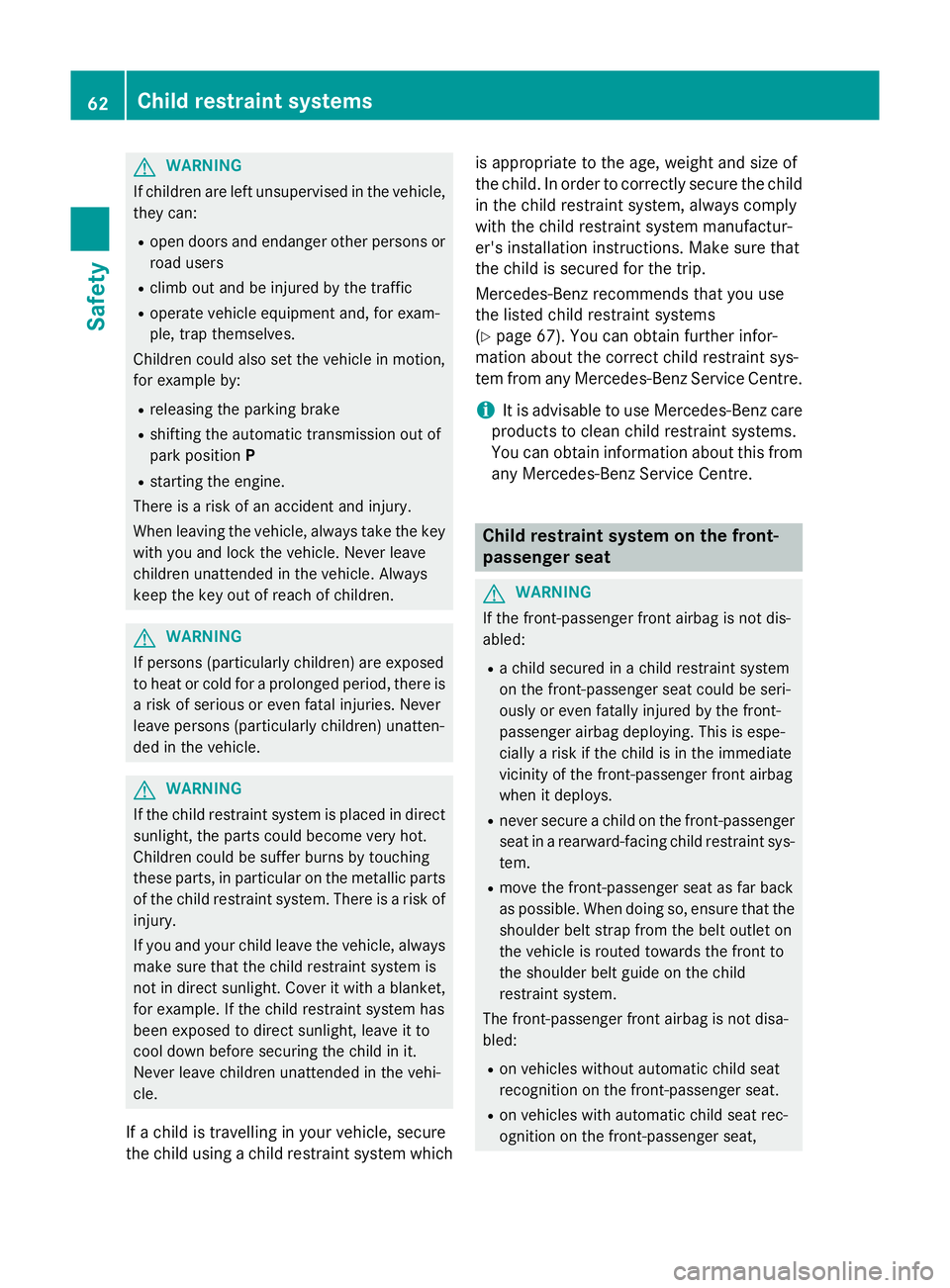
G
WARNING
If children are left unsupervised in the vehicle, they can:
R open doors and endanger other persons or
road users
R climb out and be injured by the traffic
R operate vehicle equipment and, for exam-
ple, trap themselves.
Children could also set the vehicle in motion, for example by:
R releasing the parking brake
R shifting the automatic transmission out of
park position P
R starting the engine.
There is a risk of an accident and injury.
When leaving the vehicle, always take the key
with you and lock the vehicle. Never leave
children unattended in the vehicle. Always
keep the key out of reach of children. G
WARNING
If persons (particularly children) are exposed
to heat or cold for a prolonged period, there is a risk of serious or even fatal injuries. Never
leave persons (particularly children) unatten-
ded in the vehicle. G
WARNING
If the child restraint system is placed in direct sunlight, the parts could become very hot.
Children could be suffer burns by touching
these parts, in particular on the metallic parts
of the child restraint system. There is a risk of injury.
If you and your child leave the vehicle, always
make sure that the child restraint system is
not in direct sunlight. Cover it with a blanket, for example. If the child restraint system has
been exposed to direct sunlight, leave it to
cool down before securing the child in it.
Never leave children unattended in the vehi-
cle.
If a child is travelling in your vehicle, secure
the child using a child restraint system which is appropriate to the age, weight and size of
the child. In order to correctly secure the child
in the child restraint system, always comply
with the child restraint system manufactur-
er's installation instructions. Make sure that
the child is secured for the trip.
Mercedes-Benz recommends that you use
the listed child restraint systems
(Y page 67). You can obtain further infor-
mation about the correct child restraint sys-
tem from any Mercedes-Benz Service Centre.
i It is advisable to use Mercedes-Benz care
products to clean child restraint systems.
You can obtain information about this from
any Mercedes-Benz Service Centre. Child restraint system on the front-
passenger seat
G
WARNING
If the front-passenger front airbag is not dis-
abled:
R a child secured in a child restraint system
on the front-passenger seat could be seri-
ously or even fatally injured by the front-
passenger airbag deploying. This is espe-
cially a risk if the child is in the immediate
vicinity of the front-passenger front airbag
when it deploys.
R never secure a child on the front-passenger
seat in a rearward-facing child restraint sys- tem.
R move the front-passenger seat as far back
as possible. When doing so, ensure that the
shoulder belt strap from the belt outlet on
the vehicle is routed towards the front to
the shoulder belt guide on the child
restraint system.
The front-passenger front airbag is not disa-
bled:
R on vehicles without automatic child seat
recognition on the front-passenger seat.
R on vehicles with automatic child seat rec-
ognition on the front-passenger seat, 62
Child restraint systemsSafety
Page 67 of 637
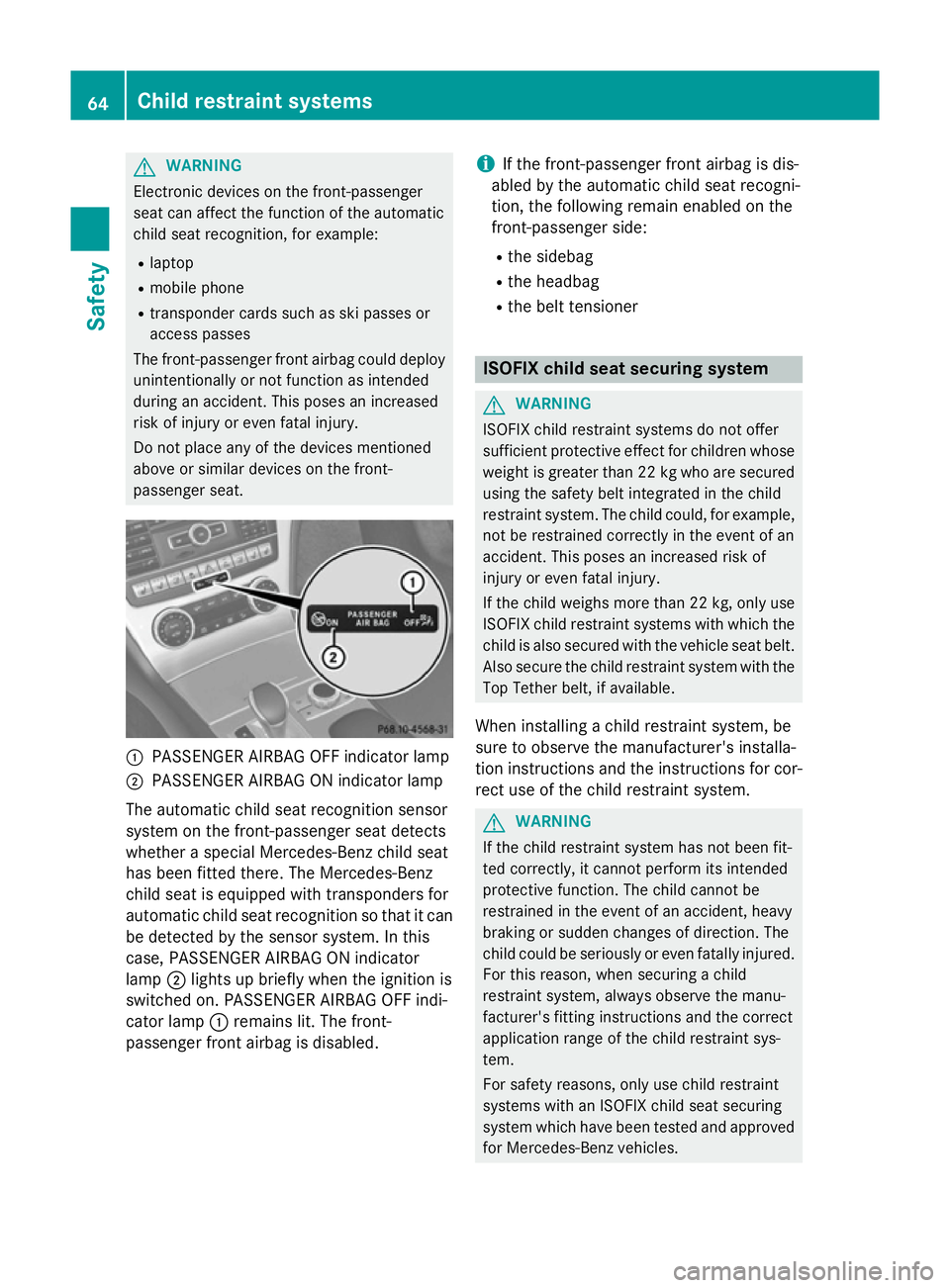
G
WARNING
Electronic devices on the front-passenger
seat can affect the function of the automatic
child seat recognition, for example:
R laptop
R mobile phone
R transponder cards such as ski passes or
access passes
The front-passenger front airbag could deploy unintentionally or not function as intended
during an accident. This poses an increased
risk of injury or even fatal injury.
Do not place any of the devices mentioned
above or similar devices on the front-
passenger seat. :
PASSENGER AIRBAG OFF indicator lamp
; PASSENGER AIRBAG ON indicator lamp
The automatic child seat recognition sensor
system on the front-passenger seat detects
whether a special Mercedes-Benz child seat
has been fitted there. The Mercedes-Benz
child seat is equipped with transponders for
automatic child seat recognition so that it can
be detected by the sensor system. In this
case, PASSENGER AIRBAG ON indicator
lamp ;lights up briefly when the ignition is
switched on. PASSENGER AIRBAG OFF indi-
cator lamp :remains lit. The front-
passenger front airbag is disabled. i
If the front-passenger front airbag is dis-
abled by the automatic child seat recogni-
tion, the following remain enabled on the
front-passenger side:
R the sidebag
R the headbag
R the belt tensioner ISOFIX child seat securing system
G
WARNING
ISOFIX child restraint systems do not offer
sufficient protective effect for children whose weight is greater than 22 kg who are securedusing the safety belt integrated in the child
restraint system. The child could, for example,not be restrained correctly in the event of an
accident. This poses an increased risk of
injury or even fatal injury.
If the child weighs more than 22 kg, only use
ISOFIX child restraint systems with which the child is also secured with the vehicle seat belt. Also secure the child restraint system with the
Top Tether belt, if available.
When installing a child restraint system, be
sure to observe the manufacturer's installa-
tion instructions and the instructions for cor- rect use of the child restraint system. G
WARNING
If the child restraint system has not been fit-
ted correctly, it cannot perform its intended
protective function. The child cannot be
restrained in the event of an accident, heavy
braking or sudden changes of direction. The
child could be seriously or even fatally injured. For this reason, when securing a child
restraint system, always observe the manu-
facturer's fitting instructions and the correct
application range of the child restraint sys-
tem.
For safety reasons, only use child restraint
systems with an ISOFIX child seat securing
system which have been tested and approved
for Mercedes-Benz vehicles. 64
Child restraint systemsSafety
Page 68 of 637
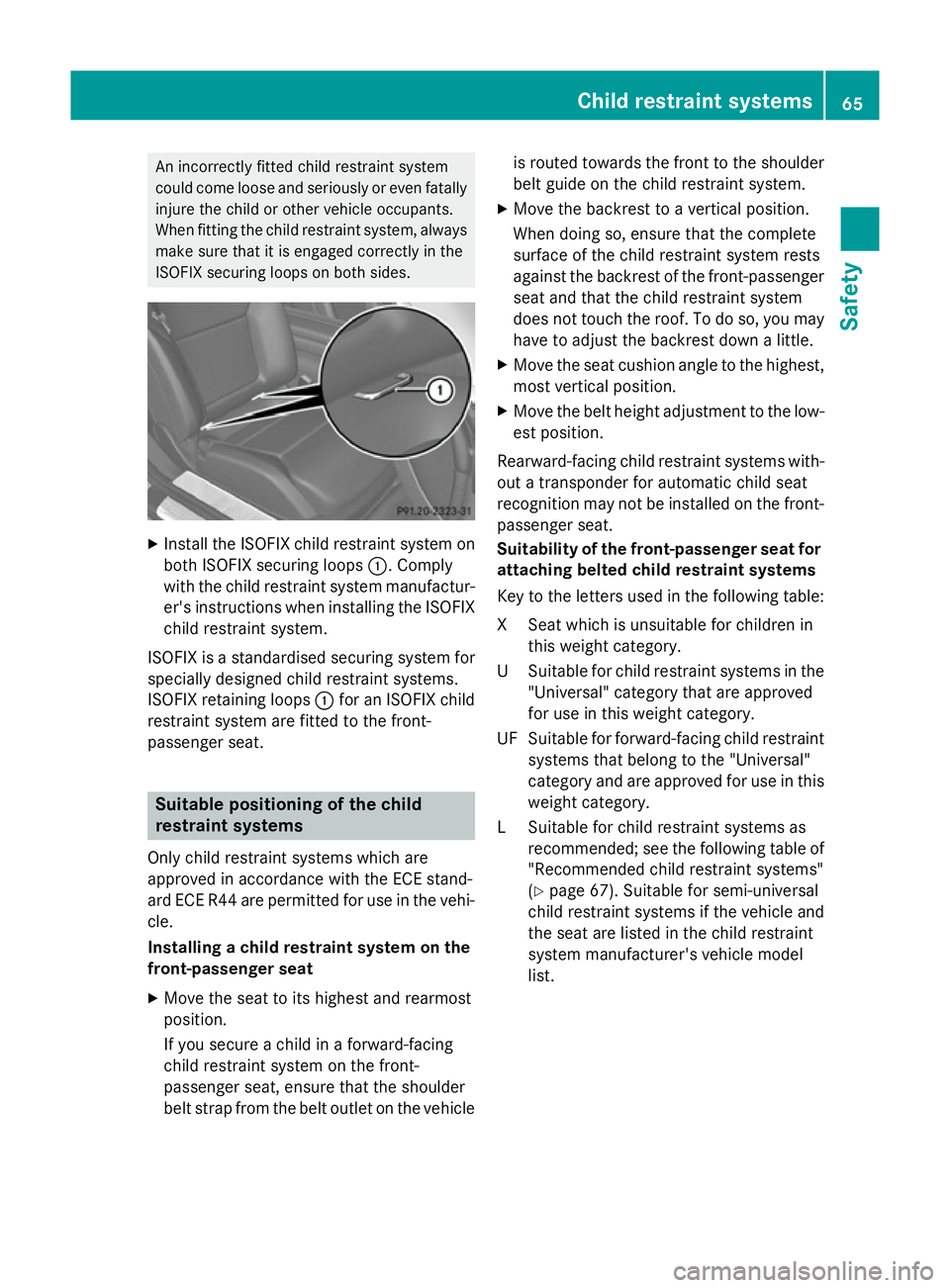
An incorrectly fitted child restraint system
could come loose and seriously or even fatally injure the child or other vehicle occupants.
When fitting the child restraint system, always
make sure that it is engaged correctly in the
ISOFIX securing loops on both sides. X
Install the ISOFIX child restraint system on
both ISOFIX securing loops :. Comply
with the child restraint system manufactur- er's instructions when installing the ISOFIXchild restraint system.
ISOFIX is a standardised securing system for
specially designed child restraint systems.
ISOFIX retaining loops :for an ISOFIX child
restraint system are fitted to the front-
passenger seat. Suitable positioning of the child
restraint systems
Only child restraint systems which are
approved in accordance with the ECE stand-
ard ECE R44 are permitted for use in the vehi- cle.
Installing a child restraint system on the
front-passenger seat
X Move the seat to its highest and rearmost
position.
If you secure a child in a forward-facing
child restraint system on the front-
passenger seat, ensure that the shoulder
belt strap from the belt outlet on the vehicle is routed towards the front to the shoulder
belt guide on the child restraint system.
X Move the backrest to a vertical position.
When doing so, ensure that the complete
surface of the child restraint system rests
against the backrest of the front-passenger
seat and that the child restraint system
does not touch the roof. To do so, you may have to adjust the backrest down a little.
X Move the seat cushion angle to the highest,
most vertical position.
X Move the belt height adjustment to the low-
est position.
Rearward-facing child restraint systems with- out a transponder for automatic child seat
recognition may not be installed on the front-
passenger seat.
Suitability of the front-passenger seat for attaching belted child restraint systems
Key to the letters used in the following table:
XS eat which is unsuitable for children in
this weight category.
US uitable for child restraint systems in the
"Universal" category that are approved
for use in this weight category.
UF Suitable for forward-facing child restraint systems that belong to the "Universal"
category and are approved for use in this
weight category.
LS uitable for child restraint systems as
recommended; see the following table of
"Recommended child restraint systems"
(Y page 67). Suitable for semi-universal
child restraint systems if the vehicle and
the seat are listed in the child restraint
system manufacturer's vehicle model
list. Child restraint systems
65Safety Z
Page 69 of 637
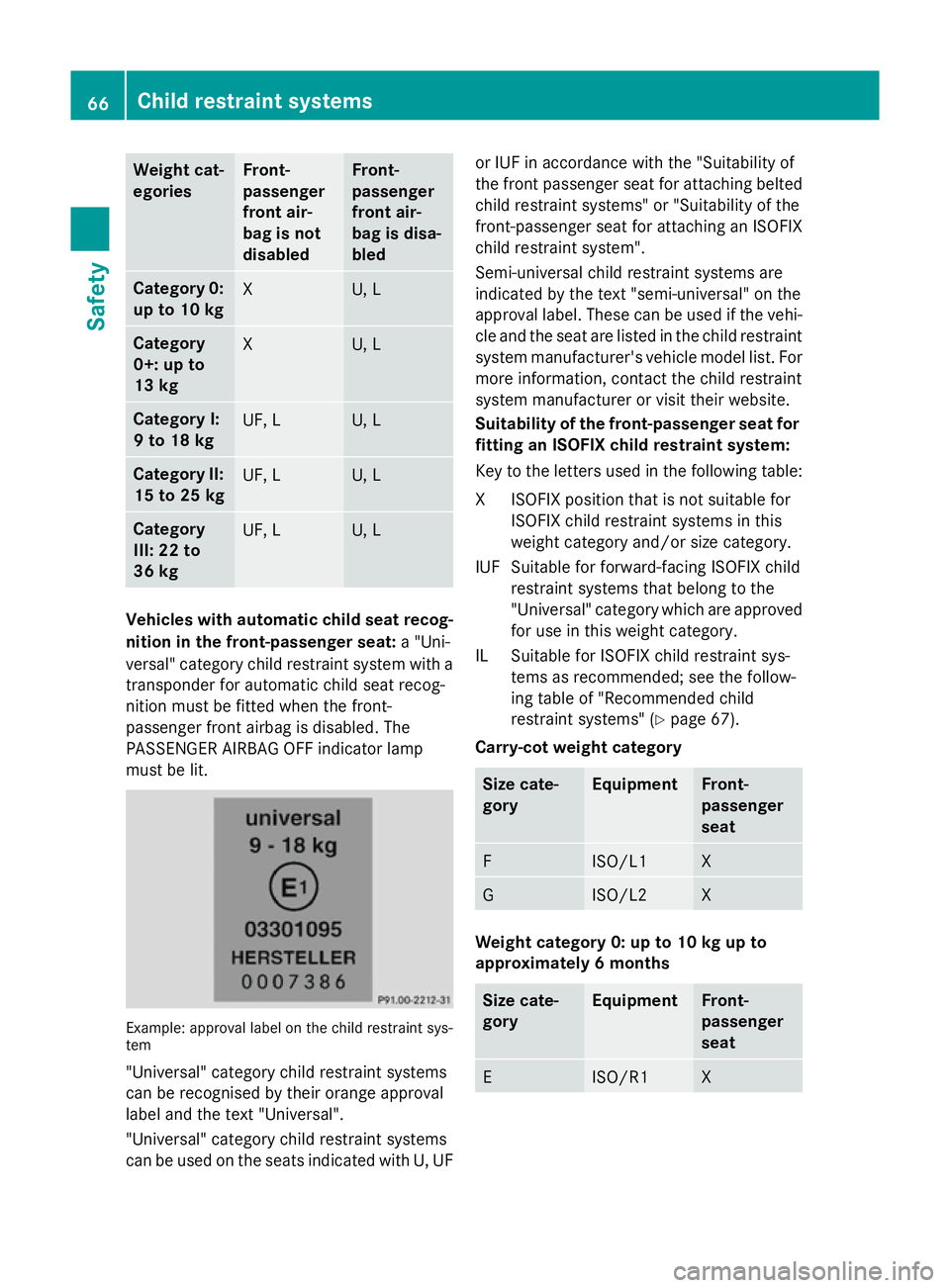
Weight cat-
egories Front-
passenger
front air-
bag is not
disabled Front-
passenger
front air-
bag is disa-
bled
Category 0:
up to 10 kg X U, L
Category
0+: up to
13 kg
X U, L
Category I:
9 to 18 kg
UF, L U, L
Category II:
15 to 25 kg UF, L U, L
Category
III: 22 to
36 kg
UF, L U, L
Vehicles with automatic child seat recog-
nition in the front-passenger seat: a "Uni-
versal" category child restraint system with a
transponder for automatic child seat recog-
nition must be fitted when the front-
passenger front airbag is disabled. The
PASSENGER AIRBAG OFF indicator lamp
must be lit. Example: approval label on the child restraint sys-
tem
"Universal" category child restraint systems
can be recognised by their orange approval
label and the text "Universal".
"Universal" category child restraint systems
can be used on the seats indicated with U, UF or IUF in accordance with the "Suitability of
the front passenger seat for attaching belted
child restraint systems" or "Suitability of the
front-passenger seat for attaching an ISOFIX
child restraint system".
Semi-universal child restraint systems are
indicated by the text "semi-universal" on the
approval label. These can be used if the vehi-
cle and the seat are listed in the child restraint system manufacturer's vehicle model list. For
more information, contact the child restraint
system manufacturer or visit their website.
Suitability of the front-passenger seat for fitting an ISOFIX child restraint system:
Key to the letters used in the following table:
XI SOFIX position that is not suitable for
ISOFIX child restraint systems in this
weight category and/or size category.
IUF Suitable for forward-facing ISOFIX child restraint systems that belong to the
"Universal" category which are approvedfor use in this weight category.
IL Suitable for ISOFIX child restraint sys- tems as recommended; see the follow-
ing table of "Recommended child
restraint systems" (Y page 67).
Carry-cot weight category Size cate-
gory Equipment Front-
passenger
seat
F ISO/L1 X
G ISO/L2 X
Weight category 0: up to 10 kg up to
approximately 6 months
Size cate-
gory Equipment Front-
passenger
seat
E ISO/R1 X66
Child restraint systemsSafety
Page 70 of 637
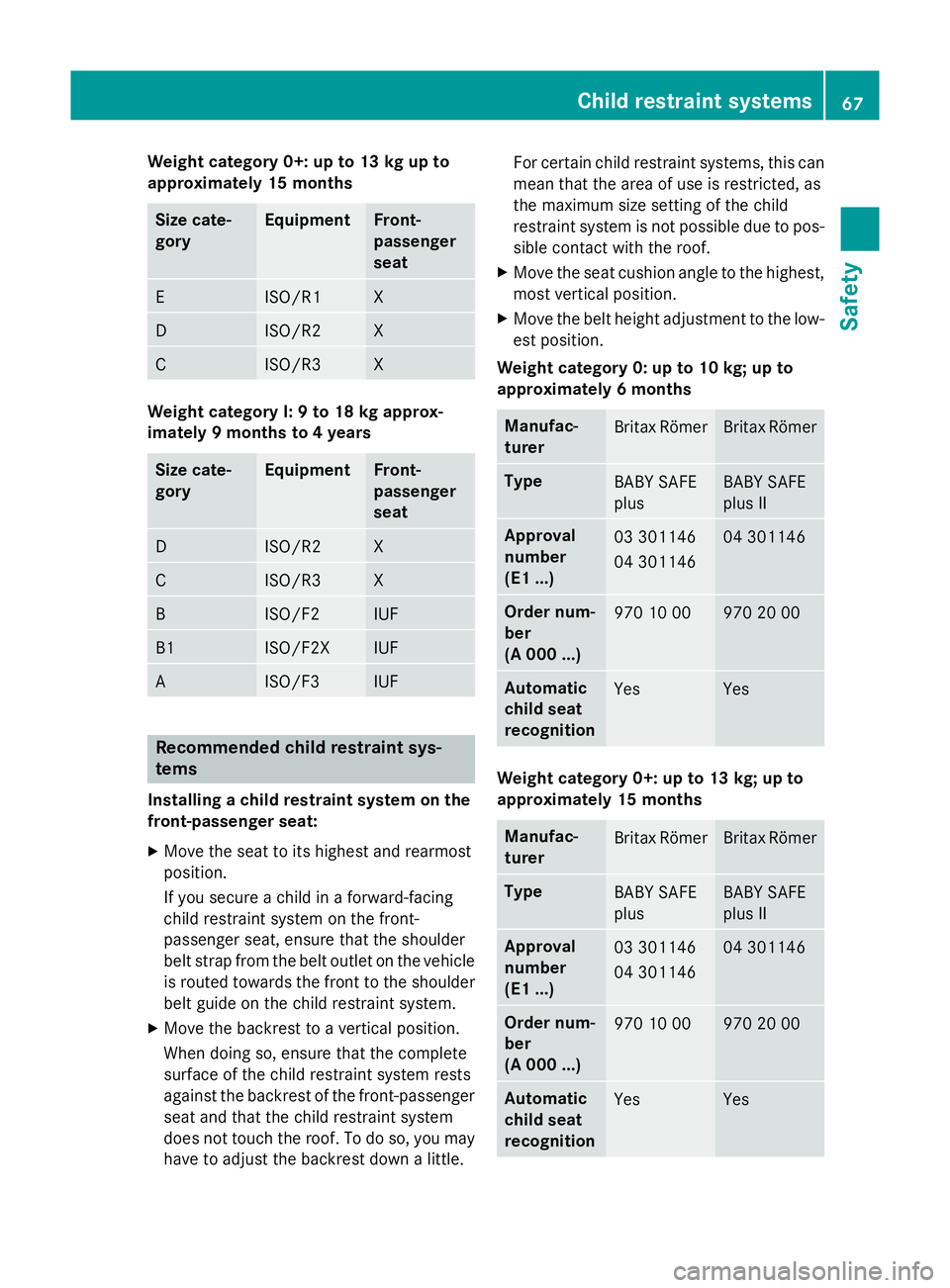
Weight category 0+: up to 13 kg up to
approximately 15 months Size cate-
gory Equipment Front-
passenger
seat
E ISO/R1 X
D ISO/R2 X
C ISO/R3 X
Weight category I: 9 to 18 kg approx-
imately 9 months to 4 years
Size cate-
gory Equipment Front-
passenger
seat
D ISO/R2 X
C ISO/R3 X
B ISO/F2 IUF
B1 ISO/F2X IUF
A ISO/F3 IUF
Recommended child restraint sys-
tems
Installing a child restraint system on the
front-passenger seat:
X Move the seat to its highest and rearmost
position.
If you secure a child in a forward-facing
child restraint system on the front-
passenger seat, ensure that the shoulder
belt strap from the belt outlet on the vehicle is routed towards the front to the shoulder
belt guide on the child restraint system.
X Move the backrest to a vertical position.
When doing so, ensure that the complete
surface of the child restraint system rests
against the backrest of the front-passenger
seat and that the child restraint system
does not touch the roof. To do so, you may have to adjust the backrest down a little. For certain child restraint systems, this can
mean that the area of use is restricted, as
the maximum size setting of the child
restraint system is not possible due to pos- sible contact with the roof.
X Move the seat cushion angle to the highest,
most vertical position.
X Move the belt height adjustment to the low-
est position.
Weight category 0: up to 10 kg; up to
approximately 6 months Manufac-
turer
Britax Römer Britax Römer
Type
BABY SAFE
plus BABY SAFE
plus II
Approval
number
(E1 ...)
03 301146
04 301146 04 301146
Order num-
ber
(A 000 ...)
970 10 00 970 20 00
Automatic
child seat
recognition
Yes Yes
Weight category 0+: up to 13 kg; up to
approximately 15 months
Manufac-
turer
Britax Römer Britax Römer
Type
BABY SAFE
plus BABY SAFE
plus II
Approval
number
(E1 ...)
03 301146
04 301146 04 301146
Order num-
ber
(A 000 ...)
970 10 00 970 20 00
Automatic
child seat
recognition
Yes YesChild restraint systems
67Safety Z
Page 71 of 637
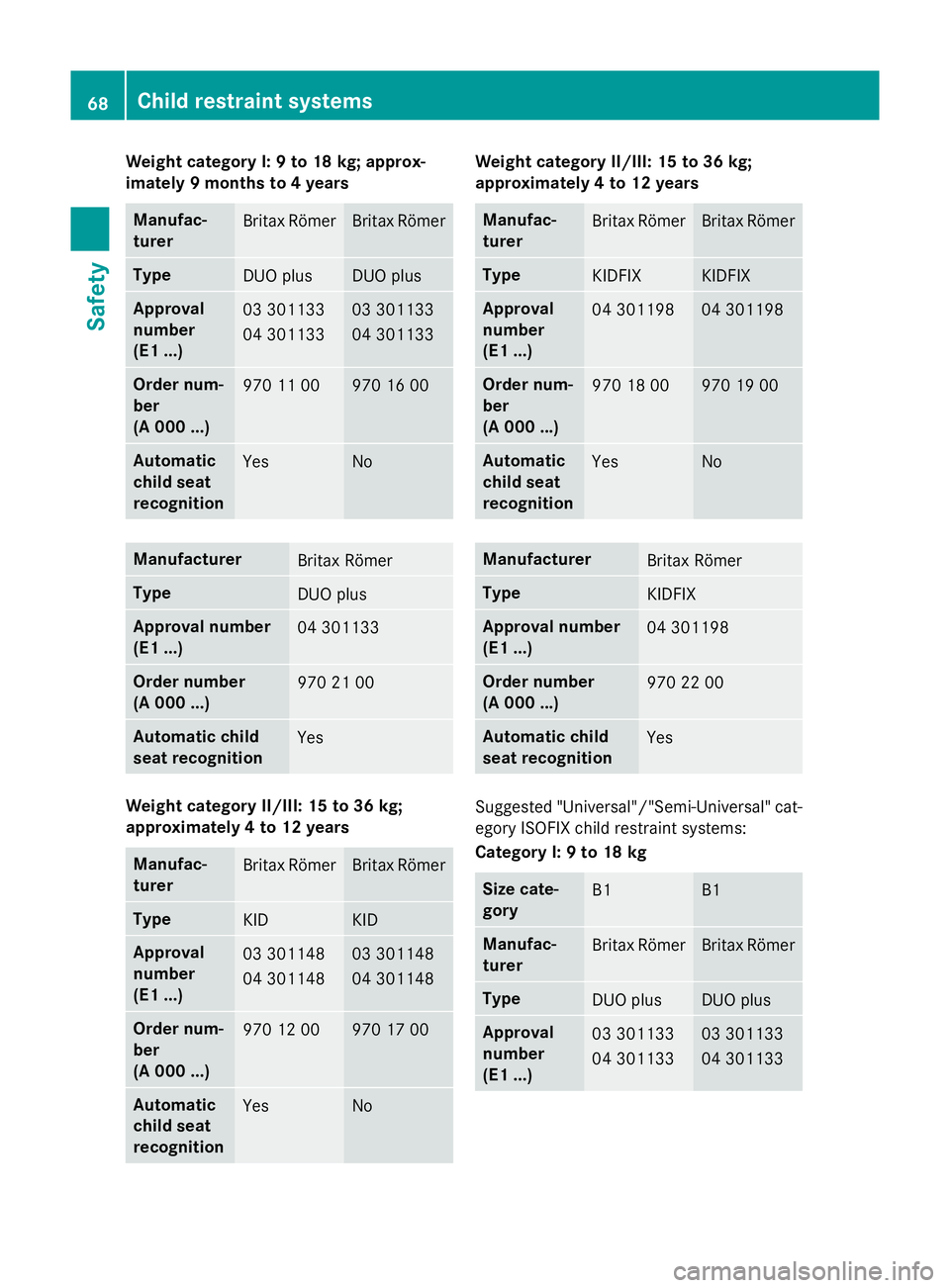
Weight category I: 9 to 18 kg; approx-
imately 9 months to 4 years
Manufac-
turer
Britax Römer Britax Römer
Type
DUO plus DUO plus
Approval
number
(E1 ...)
03 301133
04 301133 03 301133
04 301133
Order num-
ber
(A 000 ...)
970 11 00 970 16 00
Automatic
child seat
recognition
Yes No
Manufacturer
Britax Römer
Type
DUO plus
Approval number
(E1 ...)
04 301133
Order number
(A 000 ...)
970 21 00
Automatic child
seat recognition
Yes
Weight category II/III: 15 to 36 kg;
approximately 4 to 12 years Manufac-
turer
Britax Römer Britax Römer
Type
KID KID
Approval
number
(E1 ...)
03 301148
04 301148 03 301148
04 301148
Order num-
ber
(A 000 ...)
970 12 00 970 17 00
Automatic
child seat
recognition
Yes No Weight category II/III: 15 to 36 kg;
approximately 4 to 12 years Manufac-
turer
Britax Römer Britax Römer
Type
KIDFIX KIDFIX
Approval
number
(E1 ...)
04 301198 04 301198
Order num-
ber
(A 000 ...)
970 18 00 970 19 00
Automatic
child seat
recognition
Yes No
Manufacturer
Britax Römer
Type
KIDFIX
Approval number
(E1 ...)
04 301198
Order number
(A 000 ...)
970 22 00
Automatic child
seat recognition
Yes
Suggested "Universal"/"Semi-Universal" cat-
egory ISOFIX child restraint systems:
Category I: 9 to 18 kg Size cate-
gory
B1 B1
Manufac-
turer
Britax Römer Britax Römer
Type
DUO plus DUO plus
Approval
number
(E1 ...)
03 301133
04 301133 03 301133
04 30113368
Child restraint systemsSafety
Page 591 of 637
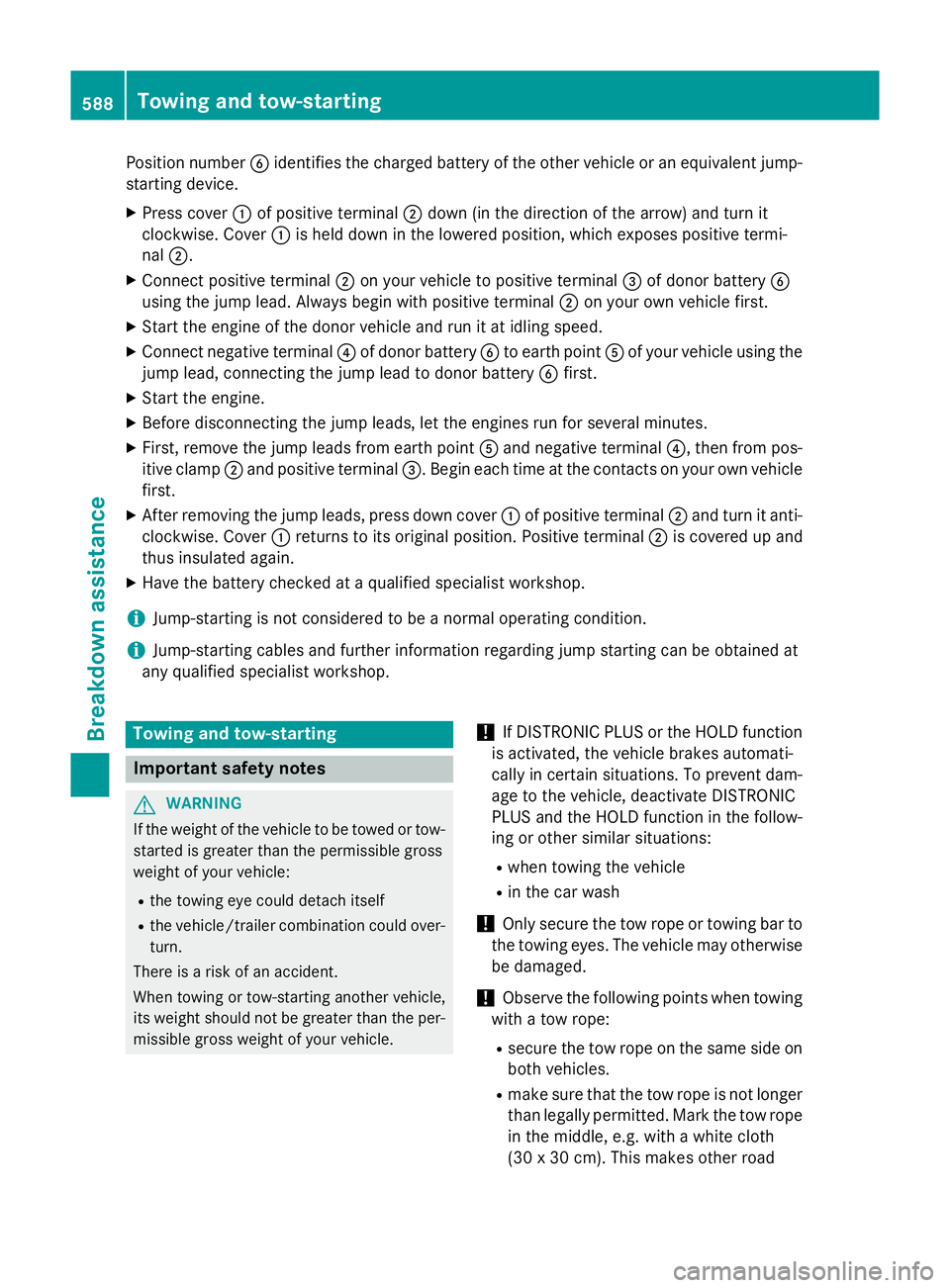
Position number
Bidentifies the charged battery of the other vehicle or an equivalent jump-
starting device.
X Press cover :of positive terminal ;down (in the direction of the arrow) and turn it
clockwise. Cover :is held down in the lowered position, which exposes positive termi-
nal ;.
X Connect positive terminal ;on your vehicle to positive terminal =of donor battery B
using the jump lead. Always begin with positive terminal ;on your own vehicle first.
X Start the engine of the donor vehicle and run it at idling speed.
X Connect negative terminal ?of donor battery Bto earth point Aof your vehicle using the
jump lead, connecting the jump lead to donor battery Bfirst.
X Start the engine.
X Before disconnecting the jump leads, let the engines run for several minutes.
X First, remove the jump leads from earth point Aand negative terminal ?, then from pos-
itive clamp ;and positive terminal =. Begin each time at the contacts on your own vehicle
first.
X After removing the jump leads, press down cover :of positive terminal ;and turn it anti-
clockwise. Cover :returns to its original position. Positive terminal ;is covered up and
thus insulated again.
X Have the battery checked at a qualified specialist workshop.
i Jump-starting is not considered to be a normal operating condition.
i Jump-starting cables and further information regarding jump starting can be obtained at
any qualified specialist workshop. Towing and tow-starting
Important safety notes
G
WARNING
If the weight of the vehicle to be towed or tow- started is greater than the permissible gross
weight of your vehicle:
R the towing eye could detach itself
R the vehicle/trailer combination could over-
turn.
There is a risk of an accident.
When towing or tow-starting another vehicle,
its weight should not be greater than the per-
missible gross weight of your vehicle. !
If DISTRONIC PLUS or the HOLD function
is activated, the vehicle brakes automati-
cally in certain situations. To prevent dam-
age to the vehicle, deactivate DISTRONIC
PLUS and the HOLD function in the follow- ing or other similar situations:
R when towing the vehicle
R in the car wash
! Only secure the tow rope or towing bar to
the towing eyes. The vehicle may otherwise be damaged.
! Observe the following points when towing
with a tow rope:
R secure the tow rope on the same side on
both vehicles.
R make sure that the tow rope is not longer
than legally permitted. Mark the tow rope in the middle, e.g. with a white cloth
(30 x 30 cm). This makes other road 588
Towing and tow-startingBreakdown assistance